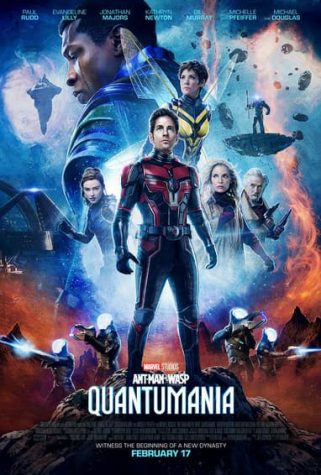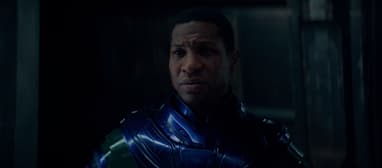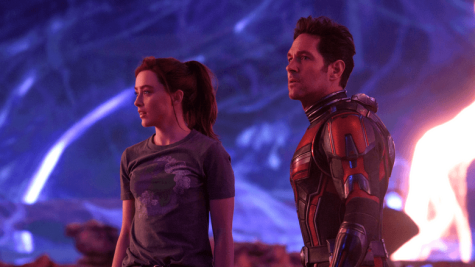REVIEW: ‘Ant-Man and the Wasp: Quantumania’ brings new levels of strange to the MCU but fails to deliver on plot
“Ant-Man and the Wasp: Quantumania” kicks off Phase 5 of the Marvel Cinematic Universe (MCU) with a zany tale of fatherhood, revolution and giant ants. Starring Paul Rudd as Ant-Man and Evangeline Lilly as the Wasp, “Quantumania” attempts to capture the vibrancy and humor of previous MCU films but struggles to deliver where it matters most.
Following the events of “Avengers: Endgame,” Scott Lang (Ant-Man) is adjusting to life as a world-renowned superhero. While trying to rebuild his tenacious relationship with his now-adult daughter Cassie (Kathryn Newton), Scott finds himself and his daughter transported into the Quantum realm, a mysterious dimension void of the rules of time and space. The duo is joined by Hope van Dyne (Wasp) and her parents–Dr. Hank Pym (Michael Douglas) and Janet van Dyne (Michelle Pfeiffer). Split apart and navigating a strange terrain, each earthly hero must confront their fears in order to reunite and return home.
One thing “Quantumania” definitely got right was its use of CGI to create a magical world worth exploring. In the otherworldly Quantum Realm, viewers are drawn into a weird and beautiful landscape populated by various creatures. From living houses to a man made entirely of goo, time spent in the Quantum Realm is a delightful escape from real-world superhero action.

However, the film occasionally feels stuck in the vast expanse of CGI, with more focus placed on the world around rather than the conflict between characters, which is where the problems begin.
Like most new MCU entries, “Quantumania” struggles to stand on its own, relying on previous audience knowledge to support crucial plot points. Casual viewers will be left with many unanswered questions concerning variants and the Quantum realm, resulting in general confusion. When characters in the film are surprised to learn of the multiverse, which has already been introduced to viewers through “Spiderman: No Way Home” and “Dr. Strange in the Multiverse of Madness,” devoted MCU fans are reminded that the interconnectedness formed in Phases 2 and 3 is largely missing from the new era of Marvel movies.
Cast connectivity is also an issue within “Quantumania,” as many character interactions feel disingenuous. Rudd and Newton lack the chemistry needed to create a believable father-daughter duo, undercutting the potential both actors bring to their respective roles. Pfeiffer also struggles to find her footing with Janet, creating uncomfortable tension with both Hope and Hank that is only mildly resolved throughout the film. Delightful casting surprises like Bill Murray as Lord Krylar and William Jackson Harper as Quaz can’t save the often-subpar acting presented throughout the film.

The real standout is Jonathan Majors, reprising his role as a variant of He Who Remains from 2021’s “Loki.” The Quantum Realm’s iteration, known as Kang the Conqueror, takes on a more sinister tone as his character unfolds during the film, showing off Majors’ range as an actor. Other notable characters include Xolum (James Cutler) and Veb (David Dastmalchian), two Quantum-beings who face off against Kang and provide genuine humor.
On a less humorous note, Corey Stoll returns to the franchise as comic favorite M.O.D.O.K. Stoll reprises his role as “Ant-Man” antagonist Daren Cross, who we last saw defeated at the hands of Rudd’s Scott Lang in the first film. M.O.D.O.K proves to be a shell of his former self and adds little to the film, existing mostly to be made fun of and providing an awkward twist on the much-anticipated introduction of M.O.D.O.K in the MCU.
In the face of these cameos, fan-favorite Luis (Michael Peña) is notably absent throughout the film. Luis brought humor to every scene he was in in previous films, marking his unexplained absence as a low point in this already struggling script. However, callbacks to Scott’s former job at Baskin-Robbins offer noble attempts at capturing the delight of the previous Ant-Man films.

Riddled with various plot holes and quantum-inconsistencies, “Quantumania” feels like fanfiction turned into a bad movie. Capped off with an anticlimactic and unfulfilling ending, the film seems to be afraid of taking risks and makes audiences wonder whether there were ever true stakes involved. The last scene of the movie adds nothing important to the MCU, reflecting the pointless nature of Ant Man’s latest adventure.
Despite its many faults, “Quantumania” is almost redeemed by two stunning mid- and end-credit scenes. The mid-credits scene adds several layers to the character of Kang and the true nature of his motives in the film, officially cementing him as the MCU’s next big villain. The end-credits scene proves to be the true highlight, with dazzling cameos and excited in-theatre fan reactions showcasing the immense potential of future MCU projects. These scenes, coupled with the fun cringe often induced by moments meant to carry more serious weight, made sitting through “Quantumania” somewhat worth it.
Whether viewing in theater or on Disney+ in a few months, “Quantumania” is a great film to laugh at on movie night with friends, so long as you don’t take it too seriously.







